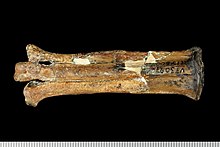| Avisaurus Temporal range: Late Cretaceous (Maastrichtian), 68–66 Ma PreꞒ Ꞓ O S D C P T J K Pg N ↓ | |
|---|---|

| |
| Holotype tarsometatarsus of A. archibaldi | |
| Scientific classification | |
| Domain: | Eukaryota |
| Kingdom: | Animalia |
| Phylum: | Chordata |
| Clade: | Dinosauria |
| Clade: | Saurischia |
| Clade: | Theropoda |
| Clade: | Avialae |
| Clade: | †Enantiornithes |
| Family: | †Avisauridae |
| Genus: | †Avisaurus Brett-Surman & Paul, 1985 |
| Type species | |
| †Avisaurus archibaldi Brett-Surman & Paul, 1985 | |
| Species | |
| |
Avisaurus (meaning "bird lizard") is a genus of enantiornithine avialan from the Late Cretaceous of North America.
Discovery
Avisaurus archibaldi was discovered in the Late Cretaceous Hell Creek Formation of North America (Maastrichtian, from c.70.6-66 million years ago), making it one of the last enantiornithids. It was collected in 1975 in the UCMP locality V73097, in Garfield County, Montana, USA. The holotype is represented by a single fossil of a tarsometatarsus in the collection of the University of California Museum of Paleontology. It has the catalog number UCMP 117600. The species name honors J. David Archibald, its discoverer, from The University of California, Berkeley. It was initially described as the left tarsometatarsus of a non-avian theropod by Brett-Surman and Paul in 1985. It was later redescribed as the right tarsometatarsus of an enantiornithine bird by Chiappe in 1992.
Avisaurus gloriae Varricchio and Chiappe 1995, discovered in the late Campanian Upper Two Medicine Formation of Glacier County, Montana, USA, was renamed Gettyia by Atterholt et al. (2018). In 2024, another species of Avisaurus from the Hell Creek Formation was named as Avisaurus darwini, with the specific name in honor of Charles Darwin.
Description

Avisaurus was a large enantiornithine, with A. darwini weighing up to 1.2 kilograms (2.6 lb) and A. archibaldi weighing up to 1.7 kilograms (3.7 lb). The type specimen of A. archibaldi has a maximum length of 73.9 mm (2.91 in), making it one of the largest known tarsometatarsi of an enantiornithine.
Classification
This genus belongs to the enantiornithine family Avisauridae, which also contains similar animals from South America such as Soroavisaurus, Neuquenornis and Intiornis.
Brett-Surman and Paul (1985) explicitly considered the possibility that A. archibaldi was an enantiornithine. The authors described and named UCMP 117600 formally, but they looked at other enantiornithine material, including the "metatarsus" PVL 4690 from Argentina. The authors assigned this latter fossil to Avisaurus sp. From this they concluded that members of the genus Avisaurus existed in both North and South America in the Late Cretaceous. Moreover, the authors concluded that the length/width ratio and degree of metacarpal fusion of these bones were more like those of non — avian dinosaurs. A terrestrial dinosaur genus in both continents would then support Brett — Surman's theory that there had been a land connection between the two continents.
Further discoveries and further study by Chiappe showed that all of the material belonged to enantiornithine birds, and PVL 4690 was given its own genus Soroavisaurus.
Paleoenvironment and paleobiology
Avisaurus remains fossilized in the humid low-lying swamps, lakes, and river basins of the western shore of the Western Interior Seaway, Hell Creek Formation.
Inwardly curved claws of the Avisaurus tarsis resemble those of eudromaeosaurs, indicating that it was predatory. It likely preyed on other vertebrates, with similarity to some modern raptors.
-
 Reconstruction of Avisaurus and Brachychampsa
Reconstruction of Avisaurus and Brachychampsa
-
 Reconstruction of Avisaurus darwini with prey
Reconstruction of Avisaurus darwini with prey
References
- PaleoBiology Database: Avisaurus, basic info
- ^ Chiappe, Luis M. (1992) "Enantiornithine (Aves) Tarsometatarsi and the Avian Affinities of the Late Cretaceous Avisauridae" "Journal of Vertebrate Paleontology" September 3, 1992, Volume 12 no. 3 pp. 344-350
- ^ Varricchio, David J., Chiappe, Luis M. (1995) "A New Enantiornithine Bird From the Upper Cretaceous Two medicine Formation of Montana" " Journal of Vertebrate Paleontology" March 14, 1995, Vol. 15, no. 1, pp. 201 - 204
- Atterholt, Jessie; Hutchison, J. Howard; O’Connor, Jingmai K. (2018-11-13). "The most complete enantiornithine from North America and a phylogenetic analysis of the Avisauridae". PeerJ. 6: e5910. doi:10.7717/peerj.5910. ISSN 2167-8359. PMC 6238772. PMID 30479894.
- ^ Clark, Alexander D.; Atterholt, Jessie; Scannella, John B.; Carroll, Nathan; O’Connor, Jingmai K. (2024-10-09). "New enantiornithine diversity in the Hell Creek Formation and the functional morphology of the avisaurid tarsometatarsus". PLOS ONE. 19 (10): e0310686. doi:10.1371/journal.pone.0310686. ISSN 1932-6203. PMC 11463745. PMID 39383133.
- Brett-Surman, Michael K., Paul, Gregory S. (1985) "A new family of bird-like dinosaurs linking Laurasia and Gondwanaland." "Journal of Vertebrate Paleontology" 5(2): 133-138.
- Matthew P. Martyniuk (2012). A Field Guide to Mesozoic Birds and Other Winged Dinosaurs. Pan Aves. p. 142. ISBN 9780988596504. Retrieved 29 August 2022.
Further reading
- Brett-Surman, Michael K. & Paul, Gregory S. (1985): A new family of bird-like dinosaurs linking Laurasia and Gondwanaland. J. Vertebr. Paleontol. 5(2): 133–138.
- Cambra-Moo, Oscar; Delgado Buscalioni, Ángela; Cubo, Jorge; Castanet, Jacques; Loth, Marie-Madeleine; de Margerie, Emmanuel & de Ricqlès, Armand (2006): Histological observations of Enantiornithine bone (Saurischia, Aves) from the Lower Cretaceous of Las Hoyas (Spain). C. R. Palevol 5(5): 685–691. doi:10.1016/j.crpv.2005.12.018 PDF fulltext
- Chiappe, Luis M. (1993): Enantiornithine (Aves) Tarsometatarsi from the Cretaceous Lecho Formation of Northwestern Argentina. American Museum Novitates 3083: 1-27. PDF fulltext
| Taxon identifiers | |
|---|---|
| Avisaurus | |

